It’s Here – the Industry’s First Truly Portable XML Form
Hopefully by now you’ve downloaded the 2011r3 versions of the Altova product line released last week. We’ve introduced a bunch of new features and functionalities that put even more power into the hands of IT professionals. (Note: If you haven’t already done so, you can download the latest versions of all of the tools in the Altova product suite from our Web site.)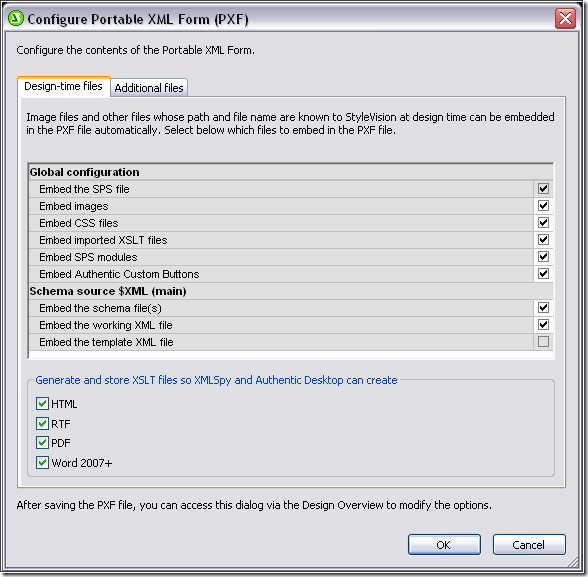 One of the features we’re most excited about is the new Portable XML Form (PXF) file for StyleVision and Authentic. The PXF is a file into which all elements required to support a StyleVision design including XML Schemas, database connections, images, etc. can be embedded. Imagine the possibilities! In this post we’ll take an in-depth look at the PXF file format as well as some use cases.
One of the features we’re most excited about is the new Portable XML Form (PXF) file for StyleVision and Authentic. The PXF is a file into which all elements required to support a StyleVision design including XML Schemas, database connections, images, etc. can be embedded. Imagine the possibilities! In this post we’ll take an in-depth look at the PXF file format as well as some use cases.
When you create a design in StyleVision and then save it as a PXF file, all design elements including XML Schema and instance documents, SPS design files, XSLT, images, and other external files are embedded in the PXF. The PXF file can be transported, downloaded, copied, and saved like any other data file, meaning that developers no longer have to send or install multiple files to support a design. This is especially useful for integrating Authentic electronic forms into your projects – and consequently great news for business users. Authentic electronic forms created in StyleVision allow business users to edit databases and XML files without wrangling with database and XML syntax. The PXF file makes developing – and using – these forms even easier. Take, for example, the bane of many a business traveler’s existence – the expense report. Fortunately for the IT professional using Altova tools the expense report is a snap – a developer can create an eye-catching report that meets the business needs of the client by taking advantage of StyleVision’s many design capabilities. 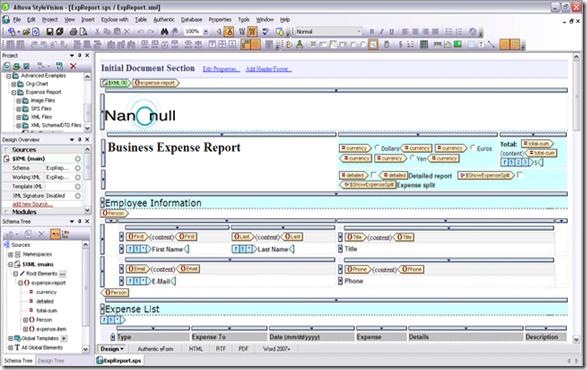 Once the design is complete, creating a PXF file is as easy as selecting Save As and toggling the Save as PXF file radio button.
Once the design is complete, creating a PXF file is as easy as selecting Save As and toggling the Save as PXF file radio button. 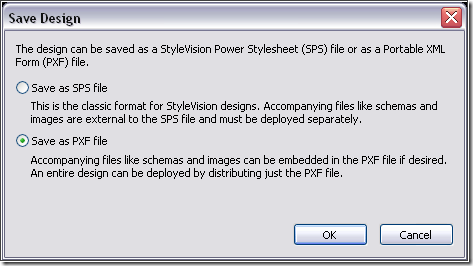 When prompted to select files to embed in the PXF, remember to check the output formats that end users will be able to publish content in.
When prompted to select files to embed in the PXF, remember to check the output formats that end users will be able to publish content in.  With all design elements now embedded in the PXF file, you can distribute the form easily and efficiently.
With all design elements now embedded in the PXF file, you can distribute the form easily and efficiently.
- Is the expense form going to be integrated into a larger project? Send the PXF file to the development lead, who will be delighted at receiving a single file rather than a bunch of individual files.
- Do business users need to access the expense form online? Rather than saving the XML Schema, instance documents, SPS, images, etc., to the server separately, simply put the PXF file on the server – everything needed to deploy the design is in the PXF.
- Ready for QA to test it? Email the PXF to the team. They will be able to deploy it simply by opening the PXF in Authentic, just as a business user would. The schema is embedded in the PXF so you can rest assured that XML and database content is being edited and updated appropriately.
- Are you dealing directly with the end user? Email the PXF to him – the Authentic Community Edition is free and easy to install so a business user can distribute the form and all associated files and data to relevant stakeholders across the organization.
The PXF is a boon to business users as well as developers. Depending on how you deploy the expense report, business users can access it via Authentic Desktop or in their browser with the Authentic Browser Plug-in. As he would with any Authentic form, an end user simply opens the PXF file in Authentic Desktop and can immediately begin editing or adding data. The associated XML file or database is updated automatically to reflect the changes. End users accessing an Authentic form via the Authentic Browser Plug-in likewise update XML and database data by entering and editing information in the form. 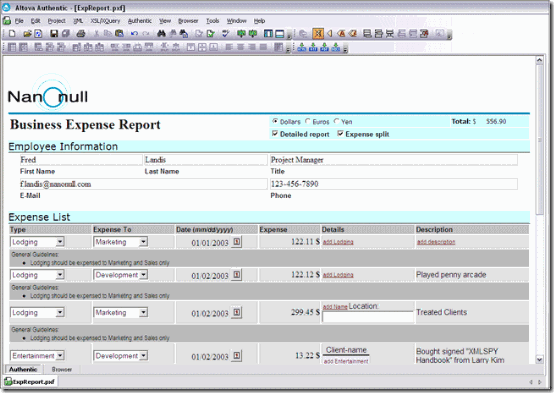 The value of the PXF for end users is the same as for the developer – portability. Because the PXF file contains all of the files necessary to support the Authentic form, including the instance document, the business user can enter his expense data, resave the file, and then send the PXF to the accounting department. He can even email the PXF directly from the application.
The value of the PXF for end users is the same as for the developer – portability. Because the PXF file contains all of the files necessary to support the Authentic form, including the instance document, the business user can enter his expense data, resave the file, and then send the PXF to the accounting department. He can even email the PXF directly from the application.  The PXF file also provides business users with the ability to publish content in multiple output formats. In our example the developer clicked HTML, RTF, PDF, and Word 2007+ in the Configure Portable XML Form (PXF) dialog box. A business user can instantly create an output document in each of these formats by clicking one of the output buttons on the menu bar.
The PXF file also provides business users with the ability to publish content in multiple output formats. In our example the developer clicked HTML, RTF, PDF, and Word 2007+ in the Configure Portable XML Form (PXF) dialog box. A business user can instantly create an output document in each of these formats by clicking one of the output buttons on the menu bar.  Here we’ve clicked the PDF button, generating a document that a business traveler can mail to the corporate office, keep for his records, etc.
Here we’ve clicked the PDF button, generating a document that a business traveler can mail to the corporate office, keep for his records, etc. 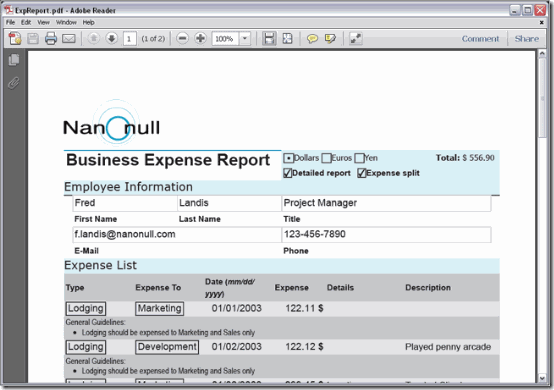 Although the portability afforded by the PXF significantly increases the value of electronic forms by simplifying the process of getting critical business data into XML, Authentic forms in general are an easy sell to business users. In addition to comprehensive editing capabilities, Authentic enhances the business value of electronic forms through features that include real-time validation of input data, industry standard XML templates, project management support, and dynamic layout based on user input. In addition to all of the functionality and editing capabilities Authentic offers, the application can compete on price – the Authentic Community Edition is free. We hope that you are as intrigued by the possibilities offered by PXF as we are. By providing developers an easy way to integrate electronic forms into their projects and a simple (and free) way for business users to distribute and publish information, PXF could radically transform the process of creating and editing XML and database content. This is a truly exciting prospect. For those of you not yet using our tools, this is a perfect time to give them a try. Click here to download free, fully functional trial versions of our software. They’re good for 30 days!
Although the portability afforded by the PXF significantly increases the value of electronic forms by simplifying the process of getting critical business data into XML, Authentic forms in general are an easy sell to business users. In addition to comprehensive editing capabilities, Authentic enhances the business value of electronic forms through features that include real-time validation of input data, industry standard XML templates, project management support, and dynamic layout based on user input. In addition to all of the functionality and editing capabilities Authentic offers, the application can compete on price – the Authentic Community Edition is free. We hope that you are as intrigued by the possibilities offered by PXF as we are. By providing developers an easy way to integrate electronic forms into their projects and a simple (and free) way for business users to distribute and publish information, PXF could radically transform the process of creating and editing XML and database content. This is a truly exciting prospect. For those of you not yet using our tools, this is a perfect time to give them a try. Click here to download free, fully functional trial versions of our software. They’re good for 30 days!
Have you used the PXF form yet? How did you use it? Please share your story with other Altova users by commenting on this blog post. Think it would make a great case study? Email us at marketing@altova.com. We’d love to hear from you!
